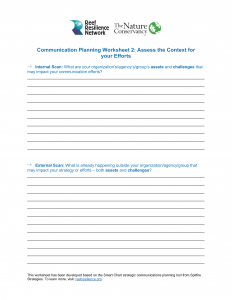Context
Step 2: Assess the Context for Your Efforts
The next step is to assess your resources and assets, clarify what conversations are happening about your issue or topic, identify potential opportunities or road blocks, and identify places where you can leverage opportunities and mitigate challenges. It’s essential to look both within your organization, agency, or community group and beyond it. What do these internal and external landscapes look like and, more importantly, how will they affect your efforts?
Your job is to understand the current conversation about your topic or issue so you can decide where your organization/agency/group fits in. Does it make sense to join the current conversation or should you start a different one? You have an opportunity to shape the way people see your topic.
Watch a short presentation about assessing the context of your efforts:
Changing the conversation like this, also called reframing, is not easy. It takes time and money, and cooperation from many. But if you see no way to achieve your objective within the current debate/conversation, it might be a worthwhile investment.
To assess the context, you need to find out what your audience and the media are saying about your organization, topic, and goal. This will help you determine how to present your messages and whether and how to change the conversation to reach your audience and achieve your goal. To do this, you can conduct formal or informal research or assessments.
Examples include:
- Conduct a media scan/analysis (read about how your topic is covered in the media, what words are being used, what headlines, what kinds of stories are being told, and how often the topic is being covered)
- Review existing research (polls or studies that have already been conducted)
- Conduct new public opinion research: interviews, focus groups, surveys, and more
- Talk with partners, colleagues, and community contacts
COMMUNICATION TIP
Good news! Information gathered during this step can later be used as baseline data. Later when you’re measuring your impact, you can refer back to this initial research and see how your project or campaign may have changed the environment/conversation/public opinion.
Test Your Understanding
Test your understanding of the information in this section by taking the quiz.
Your Turn (> 20 minutes recommended)
Conduct an internal scan of y our organization/agency/ group’s assets and challenges. Use the Context Worksheet to capture the results of a brainstorming session. A simple bulleted list is sufficient.
our organization/agency/ group’s assets and challenges. Use the Context Worksheet to capture the results of a brainstorming session. A simple bulleted list is sufficient.
Guiding questions for internal scan:
- Is your group/organization members/staff in agreement on its goals and objectives?
- What resources does your group have available, e.g. people, budgets, reputation, relationships/partnerships, etc.?
- What are you/your team/partners good and not-so-good at?
- Do you or your partners have media relationships?
- Are there other projects or communications efforts addressing the same issue?
- What kind of budget, staff, time, and management support can you expect?
- Does your group have allies (or opponents)? Who are they and what is their capacity and willingness to participate? If you have partners/allies, what are their reputations like, i.e. good/bad?
- What challenges does your group face within your community? Are there social or political concerns that could draw attention or budget away from your goal?
Next is an external scan to assess what’s happening outside your organization/agency/group. These external factors may impact your assets, challenges, and strategy so give this careful attention.
Guiding questions for external scan:
- What issues are being talked about in the community, state, island, and media? Specifically, what’s happening that could have an impact on your project?
- Who are potential experts that should be contacted to get more information about the problem?
- Are there active supporters or opposition for your topic/issue?
- Is your group, organization, or topic widely known and/or being discussed? If so, what are people saying?
- Are there misconceptions or misinformation surrounding your issue?
- What voices are being heard? Are they in support of your topic?
- Where are you in the political cycle, e.g. elections, legislative session? Is the political landscape favorable?
- Are there any policies or laws that might affect your strategy?
- What current events could affect your project – either attract positive or negative attention? (Is there an external event like the Olympics or an extreme weather event that gives you a chance to raise an issue that couldn’t be raised before?)
This worksheet is based on Spitfire Strategies’ Smart Chart® strategic communications planning tool. The Smart Chart is a registered trademark of Spitfire Strategies. To learn more, visit: spitfirestrategies.com.
